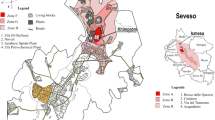Abstract
A factory in Amman Garh near Nowshera, Khyber Pakhtunkhwa, Pakistan, produced dichlorodiphenyltrichloroethane (DDT) from 1963–1994. Consequently, earlier papers reported a soil contamination in the per mille range inside the former factory wall (88 m × 106 m) and up to 10 mg/kg of DDT in the surroundings in 2005–2007. The site within the factory wall was remonitored systematically in 2011 to complement the earlier data as a prerequisite for remediation, to put them in exposure context in a population developing area, and to suggest and evaluate the optimal remediation technique for the site. The contamination was drastically higher than the earlier published data, and the sum of DDT and its metabolites (ΣDDT) was up to 65 % in the soil. Grasses, shrubs, and trees growing in this severely contaminated site had 50–450 mg/kgdw of ΣDDT. Thus, people living nearby and husbandry as well as wild animals are heavily exposed to DDT. The semiarid climate favors wind drift and deposition of the pollutant. Additionally, DDT from products of herbivore animals feeding on the contaminated plants will enter the food web. To overcome the exposure and distribution of the DDT, the site within the factory wall was capped with 1.5 m of soil. This remediation technique represents the easiest and least expensive solution. Nevertheless, DDT can still evaporate or leach, and groundwater can rise in this flood-prone area and thereby become contaminated, especially because a binding layer is missing.





Similar content being viewed by others
References
Ahad K, Mohammad A, Khan H, Ahmad I, Hayat Y (2010) Monitoring results for organochlorine pesticides in soil and water from selected obsolete pesticide stores in Pakistan. Environ Monit Assess 166:191–199
Artiola JF, Pepper IL, Brusseau M (2004) Environmental monitoring and characterization. Elsevier Academic Press, Burlington
Aslund MLW, Lunney AI, Rutter A, Zeeb BA (2010) Effects of amendments on the uptake and distribution of DDT in Cucurbita pepo ssp pepo plants. Environ Pollut 158:508–513
Azmi MA, Naqvi SNH, Azmi MA, Aslam M (2006) Effect of pesticide residues on health and different enzyme levels in the blood of farm workers from Gadap (rural area) Karachi-Pakistan. Chemosphere 64:1739–1744
Bartelt-Hunt SL, Smith JA, Burns SE, Rabideau AJ (2005) Evaluation of granular activated carbon, shale, and two organoclays for use as sorptive amendments in clay landfill liners. J Geotech Geoenviron 131:848–856
Bartelt-Hunt SL, Culver TB, Smith JA, Matott LS, Rabideau AJ (2006) Optimal design of a compacted soil liner containing sorptive amendments. J Environ Eng-Asce 132:769–776
Bouwman H, Kylin H, Sereda B, Bornman R (2012) High levels of DDT in breast milk: intake, risk, lactation duration, and involvement of gender. Environ Pollut 170:63–70
Buczyńska A, Szadkowska-Stańczyk I (2005) Identification of health hazards to rural population living near pesticide dump sites in Poland. Int J Occup Med Environ Health 18:331–339
Castelo-Grande T, Augusto PA, Monteiro P, Estevez AM, Barbosa D (2010) Remediation of soils contaminated with pesticides: a review. Int J Environ Anal Chem 90:438–467
Cliath MM, Spencer WF (1972) Dissipation of pesticides from soil by volatilization of degradation products. 1. Lindane and DDT. Environ Sci Technol 6:910–914
Colborn T, Dumanoski D, Myers JP (1997) Our stolen future: are we threatening our fertility, intelligence, and survival?—a scientific detective story. Penguin Books, USA Inc, New York
Collins C, Fryer M, Grosso A (2006) Plant uptake of non-ionic organic chemicals. Environ Sci Technol 40:45–52
Cornelissen G, Gustafsson Ö, Bucheli TD, Jonker MTO, Koelmans AA, Van Noort PCM (2005) Extensive sorption of organic compounds to black carbon, coal, and kerogen in sediments and soils: mechanisms and consequences for distribution, bioaccumulation, and biodegradation. Environ Sci Technol 39:6881–6895
Desaules A, Ammann S, Blum F, Brändli RC, Bucheli TD, Keller A (2008) PAH and PCB in soils of Switzerland—status and critical review. J Environ Monitor 10:1265–1277
Elfvendahl S, Mihale M, Kishimba MA, Kylin H (2004) Pesticide pollution remains severe after cleanup of stockpile of obsolete pesticides at Vikuge, Tanzania. Ambio 33:504–509
Eqani S, Malik RN, Alamdar A, Faheem H (2012) Status of organochlorine contaminants in the different environmental compartments of Pakistan: a review on occurrence and levels. Bull Environ Contam Tox 88:303–310
Faroon O, Harris M, Llados F, Swarts S, Sage V, Citra M, Gefell D (2002) Toxicological profile for DDT, DDE, and DDD. ATSDR (Agency for Toxic Substances and Disease Registry) 497 pages
Ghosh U, Luthy RG, Cornelissen G, Werner D, Menzie CA (2011) In-situ sorbent amendments: a new direction in contaminated sediment management. Environ Sci Technol 45:1163–1168
Gonzalez M, Miglioranza KSB, de Moreno JEA, Moreno VJ (2003) Organochlorine pesticide residues in leek (Allium porrum) crops grown on untreated soils from an agricultural environment. J Agr Food Chem 51:5024–5029
Götz R, Sokollek V, Weber R (2012) The dioxin/POPs legacy of pesticide production in Hamburg: part 2—waste deposits and remediation of Georgswerder landfill. Environ Sci Pollut Res. doi:10.1007/s11356-012-0986-x, Online; pp. 1–12
Gyalpo T, Fritsche L, Bouwman H, Bornman R, Scheringer M, Hungerbühler K (2012) Estimation of human body concentrations of DDT from indoor residual spraying for malaria control. Environ Pollut 169:235–241
Hilber I, Bucheli TD (2010) Activated carbon amendment to remediate contaminated sediments and soils: a review. Global Nest J 12:305–307
Hilber I, Maeder P, Schulin R, Wyss GS (2008) Survey of organochlorine pesticides in horticultural soils and there grown Cucurbitaceae. Chemosphere 73:954–961
Jan MR, Shah J, Khawaja MA, Gul K (2009) DDT residue in soil and water in and around abandoned DDT manufacturing factory. Environ Monit Assess 155:31–38
Khwaja MA (2008) POPs hot spot soil contamination due to a demolished dichlorodiphenyltrichloroethane (persistent organic pollutant) factory, Nowshera, NWFP, Pakistan. Ann Ny Acad Sci 1140:113–120
Khwaja MA, Jan MR, Gul K (2006) Physical verification and study of contamination of soil and water in and surrounding areas of abandoned persistent organic pollutant (DDT) factory in North West Frontier Province (NWFP) Pakistan. Sustainable Development Policy Institute SDPI, Islamabad, Pakistan p. 54
Khwaja MA, Jan MR, Gul K (2007) Study of contamination of soil in surrounding of abandoned persistant organic pollutant (DDT) factory in North West Frontier Province (NWFP) Pakistan. Sustainable Development Policy Institute SDPI, Islamabad, Pakistan p. 39
Kromidas S (2000) Validierung in der Analytik. Weinheim, Germany
Kylin H (1996) Airborne lipophilic pollutants in pine needles. Environ Sci Pollut Res 3:218–223
Kylin H, Sjödin A (2003) Accumulation of airborne hexachlorocyclohexanes and DDT in pine needles. Environ Sci Technol 37:2350–2355
Lopez-Avila V, Schoen S, Milanes J, Beckert WF (1988) Single-laboratory evaluation of EPA method 8080 for determination of chlorinated pesticides and polychlorinated-biphenyls in hazardous wastes. J Assoc Off Ana Chem 71:375–387
Lowry GV, Murphy PJ, Marquette A, Reible D (2006) Sorbent-amended “active” sediment caps for in-place management of PCB-contaminated sediments. In: Calabrese EJ, Kostecki PT, Dragun J (eds) Contaminated soils, sediments and water, vol 10. Springer-Verlag, New York, NY, pp 379–391
Lunney AI, Zeeb BA, Reimer KJ (2004) Uptake of weathered DDT in vascular plants: potential for phytoremediation. Environ Sci Technol 38:6147–6154
Lunney AI, Rutter A, Zeeb BA (2010) Effect of organic matter additions on uptake of weathered DDT by Cucurbita pepo ssp pepo cv. Howden. Int J Phytorem 12:404–417
Marco JAM, Kishimba MA (2005) Concentrations of pesticide residues in grasses and sedges due to point source contamination and the indications for public health risks, Vikuge, Tanzania. Chemosphere 61:1293–1298
Minh NH, Minh TB, Kajiwara N, Kunisue T, Subramanian A, Iwata H, Tana TS, Baburajendran R, Karuppiah S, Viet PH, Tuyen BC, Tanabe S (2006) Contamination by persistent organic pollutants in dumping sites of Asian developing countries: implication of emerging pollution sources. Arch Environ Con Tox 50:474–481
Mitra J, Raghu K (1998) Long term DDT pollution in tropical soils: effect of DDT and degradation products on soil microbial activities leading to soil fertility. B Environ Contam Tox 60:585–591
Mitton FM, Gonzalez M, Pena A, Miglioranza KSB (2012) Effects of amendments on soil availability and phytoremediation potential of aged p, p ′-DDT, p, p ′-DDE and p, p ′-DDD residues by willow plants (Salix sp.). J Hazard Mater 203:62–68
Murphy P, Marquette A, Reible D, Lowry GV (2006) Predicting the performance of activated carbon-, coke-, and soil-amended thin layer sediment caps. J Environ Eng-Asce 132:787–794
Noegrohati S, Narsito HS, Sanjayadi (2008) Fate and behavior of organochlorine pesticides in the Indonesian tropical climate: a study in the Segara Anakan estuarine ecosystem. Clean-Soil Air Water 36:767–774
Pakistan Government (2009) National implementation plan (NIP) for phasing out and elimination of POPs from Pakistan under Stockholm Convention article 7(a). p. 842. http://chm.pops.int/Implementation/NIPs/NIPSubmissions/tabid/253/Default.aspx
Quinn L, Pieters R, Nieuwoudt C, Borgen AR, Kylin H, Bouwman H (2009) Distribution profiles of selected organic pollutants in soils and sediments of industrial, residential and agricultural areas of South Africa. J Environ Monitor 11:1647–1657
Shen L, Wania F (2005) Compilation, evaluation, and selection of physical-chemical property data for organochlorine pesticides. J Chem Eng Data 50:742–768
Somasundaram L, Coats JR (1991) Pesticide transformation products in the environment. ACS Symposium Series 459:2–9
Stockholm Convention (2008) Stockholm convention on persistent organic pollutants. At http://www.pops.int. Accessed November 2012
Tariq MI, Afzal S, Hussain I, Sultana N (2007) Pesticides exposure in Pakistan: a review. Environ Int 33:1107–1122
Tutiempo Network SL (2012) http://www.tutiempo.net/en/Climate/Peshawar/08-2008/415300.htm. Accessed March 2012.
UNEP, AMAP (2011) Climate change and POPs: predicting the impacts. p. 66
Vega FA, Covelo EE, Andrade ML (2007) Accidental organochlorine pesticide contamination of soil in Porrino, Spain. J Environ Qual 36:272–279
Vijgen J, Abhilash PC, Li YF, Lal R, Forter M, Torres J, Singh N, Yunus M, Tian CG, Schaffer A, Weber R (2011) Hexachlorocyclohexane (HCH) as new Stockholm Convention POPs—a global perspective on the management of Lindane and its waste isomers. Environ Sci Pollut Res 18:152–162
Voerman S, Besemer AFH (1975) Persistence of dieldrin, lindane, and DDT in a light sandy soil and their uptake by grass. Bull Environ Contam Tox 13:501–505
Wania F, Mackay D (1996) Tracking the distribution of persistent organic pollutants. Environ Sci Technol 30:A390–A396
Weber R, Varbelow H (2012) Dioxin/POPs legacy of pesticide production in Hamburg: part 1—securing of the production area. Environ Sci Pollut Res Int (in press)
WHO (2007) The use of DDT in malaria vector control. Global malaria program
Willett LB, O’Donnell AF, Durst HI, Kurz MM (1993) Mechanisms of movement of organochlorine pesticides from soils to cows via forages. J Dairy Sci 76:1635–1644
Ying GG, Kookana RS, Mallavarpu M (2005) Release behavior of triazine residues in stabilised contaminated soils. Environ Pollut 134:71–77
Zeeb BA, Amphlett JS, Rutter A, Reimer KJ (2006) Potential for phytoremediation of polychlorinated biphenyl-(PCB-)contaminated soil. Int J Phytoremediation 8:199–221
Zurek J, Samsonowicz A, Gosk E (1993) Chemical dump sites in Poland. Land Degrad Rehabil 4:415–420
Acknowledgments
The authors thank the Swiss National Science Foundation for funding this Joint Research Project between Pakistan and Switzerland. Furthermore, all the helpers from the Environmental Science Department of Peshawar University, Peshawar, Pakistan, and from the Sustainable Development Policy Institute, Islamabad, Pakistan, are thanked for their work in the monitoring study. The authors are also grateful for the motivating and supporting assessment of this manuscript by the reviewers.
Author information
Authors and Affiliations
Corresponding author
Additional information
Responsible editor: Leif Kronberg
Rights and permissions
About this article
Cite this article
Younas, A., Hilber, I., ur Rehman, S. et al. Former DDT factory in Pakistan revisited for remediation: severe DDT concentrations in soils and plants from within the area. Environ Sci Pollut Res 20, 1966–1976 (2013). https://doi.org/10.1007/s11356-012-1317-y
Received:
Accepted:
Published:
Issue Date:
DOI: https://doi.org/10.1007/s11356-012-1317-y




